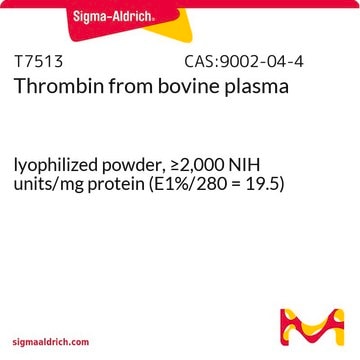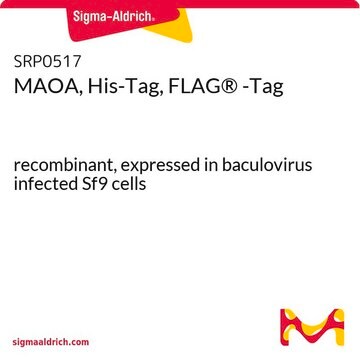SRP0676
Sortase A, S. aureus, His-tag
Staphylococcus aureus, recombinant, N-terminal His-Tag
Sinónimos:
SrtA, sortase A
Iniciar sesiónpara Ver la Fijación de precios por contrato y de la organización
About This Item
UNSPSC Code:
41202061
Productos recomendados
recombinant
expressed in E. coli
tag
His tagged
form
liquid
mol wt
27.7 kDa
UniProt accession no.
storage temp.
−70°C
General description
Our comprehensive portfolio of upstream process chemicals not only provides biopharmaceutical manufacturers with high-quality raw materials for production of classical and novel therapies, but also helps them get to market faster and simplify regulatory challenges. Trust us to deliver supply chain transparency and reliable sourcing around the globe, streamlining your product qualification with best-in-class regulatory support and service.
Application
This product is suitable for in vitro ligation of proteins and peptides to other. Sortase A has been shown to create circularized proteins [1], as well as couple polypeptides to a wide range of substituents including polymers [2], lipids [3], fluorophores [4], sugars [5], microspheres [3], peptide nucleic acids [6], among others.
Biochem/physiol Actions
Staphylococcal Sortase A is a bacterial transpeptidase that covalently links proteins to the bacterial cell wall by cleaving between threonine and glycine at an LPXTG recognition motif and catalyzes the formation of an amide bond between the carboxyl-group of threonine and the amino-group of the cell-wall peptidoglycan [7]. This chemistry can be exploited to site-specifically link proteins/peptides with the C-terminal LPETGX motif to other proteins or molecules possessing a glycine or aminomethylene motif [8].
Physical form
Aqueous buffered solution containing: 40 mM Tris-HCl, pH 8.0, 110 mM NaCl, 2.2 mM KCl, 8 mM imidazole, 0.04% Tween-20, and 20% glycerol
Analysis Note
Analysis of this product can be performed in a reaction buffer (50 μl) containing 50 mM HEPES (pH=7.4), 150 mM NaCl, 5 mM CaCl2, 5 mM (Gly)3, 25 mM Abz/Dnp substrate, and Sortase A for 30 min at 30°C. Fluorescence intensity is measured at Ex320nm/Em420nm.
Storage Class
10 - Combustible liquids
wgk_germany
WGK 2
flash_point_f
Not applicable
flash_point_c
Not applicable
Certificados de análisis (COA)
Busque Certificados de análisis (COA) introduciendo el número de lote del producto. Los números de lote se encuentran en la etiqueta del producto después de las palabras «Lot» o «Batch»
¿Ya tiene este producto?
Encuentre la documentación para los productos que ha comprado recientemente en la Biblioteca de documentos.
Hongyuan Mao et al.
Journal of the American Chemical Society, 126(9), 2670-2671 (2004-03-05)
Sortase (SrtA), a transpeptidase from Staphylococcus aureus, catalyzes a cell-wall sorting reaction at an LPXTG motif by cleaving between threonine and glycine and subsequently joining the carboxyl group of threonine to an amino group of pentaglycine on the cell wall
Stephan Pritz et al.
The Journal of organic chemistry, 72(10), 3909-3912 (2007-04-17)
Sortase A is a transpeptidase that cleaves at a pentapeptide-motif and subsequently transfers the acyl component to a nucleophile containing N-terminal oligoglycines. We investigate the reaction conditions of the sortase-mediated ligation and demonstrate a useful application by the synthesis of
John M Antos et al.
Journal of the American Chemical Society, 130(48), 16338-16343 (2008-11-08)
A general chemoenzymatic method for the site-specific attachment of lipids to protein substrates is described. Sortase A is used to append short lipid-modified oligoglycine peptides to the C terminus of protein substrates bearing a five amino acid sortase A recognition
Maximilian W Popp et al.
Proceedings of the National Academy of Sciences of the United States of America, 108(8), 3169-3174 (2011-02-08)
Recombinant protein therapeutics often suffer from short circulating half-life and poor stability, necessitating multiple injections and resulting in limited shelf-life. Conjugation to polyethylene glycol chains (PEG) extends the circulatory half-life of many proteins, but the methods for attachment often lack
Peptide-sugar ligation catalyzed by transpeptidase sortase: a facile approach to neoglycoconjugate synthesis.
Sharmishtha Samantaray et al.
Journal of the American Chemical Society, 130(7), 2132-2133 (2008-01-31)
Nuestro equipo de científicos tiene experiencia en todas las áreas de investigación: Ciencias de la vida, Ciencia de los materiales, Síntesis química, Cromatografía, Analítica y muchas otras.
Póngase en contacto con el Servicio técnico








